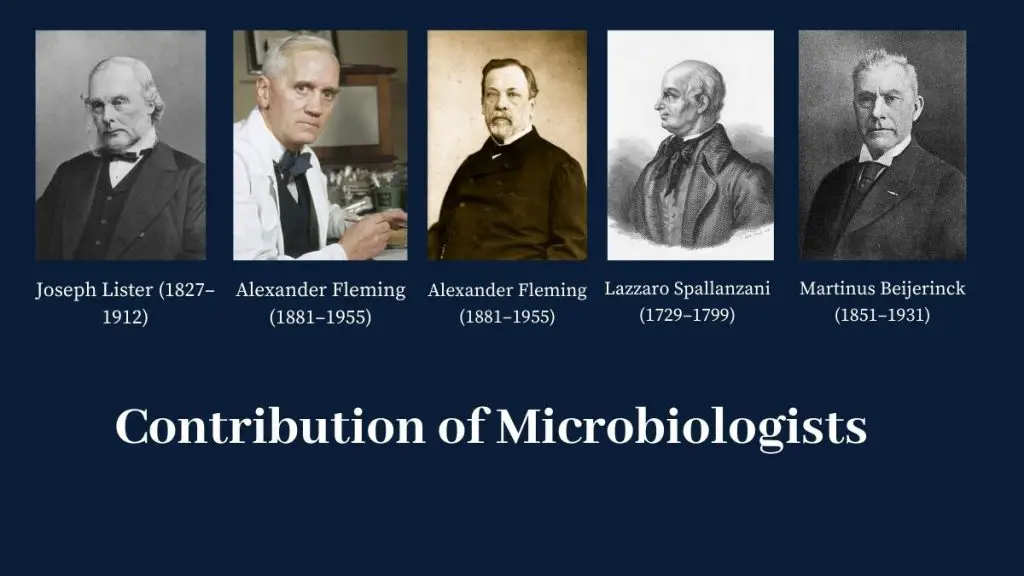Table of Contents
Contribution of Microbiologists

1. Joseph Lister
- Joseph Lister was a British surgeon and medical scientist.
- He was born on April 5, 1827.
- Joseph Lister is well known for the discovery of antiseptic medicine and a pioneer in preventive medicine.
- He was a fellow of the Royal College of Surgeons.
- He also called the father of modern Surgery.
- He died at the age of 84 on 10 February 1912.
Contributions
- He developed an achromatic lens for microscopes.
- He discover the techniques of antiseptic treatment of wounds. He published this technique in a medical journal “The Lancet”.
- He wrote an important paper on inflammation.
2. Alexander Fleming
- Alexander Fleming was a Scottish physician and microbiologist.
- He was born on 6 August 1881.
- He was well known for his discoveries of antibiotic substance benzylpenicillin (Penicillin G) from the mold Penicillium Rubens in 1928.
- For his work, he received Nobel Prize in Physiology or Medicine in 1945.
- He died on 11 March 1955.
Contribution
- He discovered antibacterial substance called “penicillin” from the Penicillium notatum
In September 1928, during his research on Staphylococcus aureus, he left open a petri plate of Staphylococcus at his window. When he came back to his laboratory from a vacation with his family, he noticed that the plate in which he was left open become contaminated with the mold, which later identified as Penicillium notatum.
He Noticed that all the bacterial cells near the molds have died. He isolate this mold from this plate and identified as Penicillium genus. He also notices that this was effective against all Gram-positive pathogens. In the beginning, he named it “mold juice”.
3. Edward Jenner
- Edward Jenner was an English physician and scientist.
- He discovered the smallpox vaccine, which was the world’s first vaccine.
- He was born on 17 May 1749and died on 26 January 1823.
Contribution
- He introduce the modern method of vaccination to prevent smallpox.
- He also discovered rheumatic heart disease.
4. Lazzaro Spallanzani
- Lazzaro Spallanzani was born on 12 January 1729.
- The nickname of Lazzaro Spallanzani was Abbé Spallanzani.
- He was an Italian Catholic priest, biologist and physiologist.
- He is well known for his study on bodily functions, animal reproduction, and animal echolocation.
- He also disproves the spontaneous generation theory by his experiment.
Contributions
- Spontaneous generation: He disprove the spontaneous generation theory by his experiment with broth.
- Digestion: He first explains the process of food digestion in the animal. He proved that the foods are digested with the action of gastric juice.
- Reproduction: He was the first person who described the animal reproduction. He first showed that both spermatozoa and ovum are required for the fertilization. Lazzaro Spallanzani first performed in Vitro fertilization.
- Echolocation: Lazzaro Spallanzani examine how bats fly at night without using their eyes for navigation, but some other sense.
- He also described how blood circulates and how respiration works.
5. Martinus Beijerinck
- Martinus Beijerinck was born on 16 March 1851.
- He was a Dutch microbiologist and botanist.
- He was was one of the founders of virology and environmental microbiology.
- Beijerinck died on 1 January 1931.
Contribution
- He was the founder of virology.
- He invented the enrichment culture.
- He experimentally demonstrated that tobacco mosaic disease is caused by an infectious agent which is smaller than a bacterium.
- He also discovered the nitrogen fixation. He explains that nitrogen gas is converted to ammonium ions which then become available to plants.
- He also discovered the sulfate reduction phenomenon of bacterial cell which was a form of anaerobic respiration.
6. Ronald Ross
- Ronald Ross was born on 13 May 1857 in Almora, North-Western Provinces, British India.
- He died at the age of 75 on 16 September 1932.
- He was a British medical doctor.
- For his work on the transmission of malaria, he received Nobel Prize in 1902.
Contribution
- He discovered the parasite of malaria, he found that malaria parasites are stored in the salivary gland of Culex mosquitoes.
- He also describes the malaria transmission in birds.
References
- https://www.slideshare.net/thatpho/joseph-lister-presentation
- https://en.wikipedia.org/wiki/Joseph_Lister
- https://www.biography.com/scientist/joseph-lister
- https://www.newscientist.com/people/joseph-lister/
- https://www.biography.com/scientist/alexander-fleming
- https://www.nobelprize.org/prizes/medicine/1945/fleming/biographical/
- https://www.britannica.com/biography/Alexander-Fleming#ref280655
- https://en.wikipedia.org/wiki/Edward_Jenner#Invention_of_the_vaccine
- https://en.wikipedia.org/wiki/Lazzaro_Spallanzani#Scientific_contributions
- https://en.wikipedia.org/wiki/Martinus_Beijerinck
